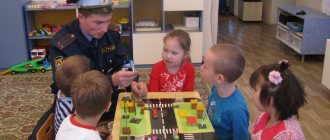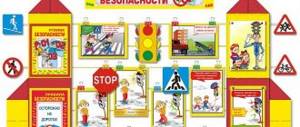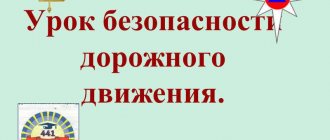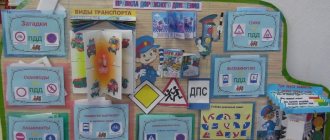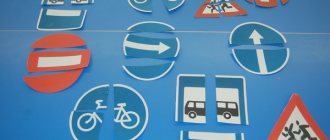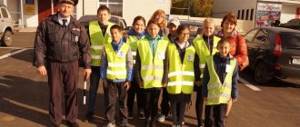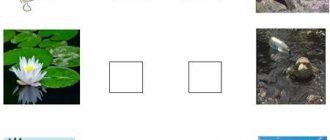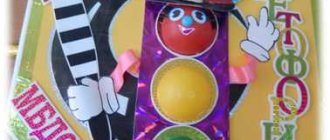Consultation for parents. “The ABCs of traffic” consultation (middle group) on the topic
Consultation for parents.
"The ABCs of Traffic".
Traffic is the same for children and adults. And the Traffic Rules are the same for everyone, but they are written in “adult” language, without any consideration for children.
Therefore, the task of adults is to clearly explain traffic rules to children. Often, in an effort to clearly convey to children the content of the Rules, some adults address children in so-called “children’s” language, consisting of nouns with diminutive suffixes. This not only does not make the Rules clear, but also distorts the real picture of traffic. After all, it’s cars, not little cars, that are dangerous on the road! You need to address children, even small ones, in normal language, without “lisping.” For the same reason, children's pictures in the style of cheerful and funny comics are also not acceptable as illustrations for teaching children traffic rules. Such pictures entertain children and distract them from the main task - to see and understand the real danger on the road and the opportunity to avoid it. Of course, this does not mean that children should be intimidated by dangers on the road. No, it is necessary to explain them clearly.
Here are some mistakes that adults make when teaching children the rules of the road:
They teach: when crossing the street, look to the left, and when you reach the middle, look to the right.
This rule is outdated and creates a dangerous situation.
Must be taught!
Before crossing the road, stop, look in both directions and, after making sure it is safe, cross the road, constantly monitoring the situation.
They teach: red – stop, yellow – get ready, green – go.
By following this rule, children gain confidence in the safety of crossing on a green signal.
But this is not at all true. Children often confuse the location of traffic lights: they do not understand that when the light is green for pedestrians, on the other hand the light is red for the driver, and vice versa.
Must be taught!
The red traffic light is prohibitive, since on the other side the green light is on for cars. Yellow – not only to get ready, but also a warning about changing traffic lights. Green - allows movement, but before entering the roadway, you must make sure that all cars have stopped.
They teach: do not play on the road, by the road, but play in the yard of the house.
But in the courtyards there are also roads along which cars drive.
Must be taught!
When leaving the entrance, be attentive and careful. Play away from the road, where there are no cars.
They teach: introduce children to a large number of road signs.
It should be remembered that road signs are mainly intended for drivers. Children need to know the meaning of signs intended for the safety of pedestrians: “Pedestrian crossing”, “Pedestrian traffic is prohibited”, “Pedestrian path”, “Children”, etc.
Summary of GCD on traffic rules in the middle group on the topic: Road ABC
Summary of direct educational activities on traffic rules in the middle group “Road ABC”.
Description:
I offer a summary of direct educational activities for children of the middle group on the topic “Road ABC”. This material will be useful to kindergarten teachers. This summary of an integrated educational activity is aimed at developing children’s knowledge of traffic rules, the development of speech and motor activity, and instilling in children the need to follow the rules on the roads.
Integration of educational areas:
“Safety”, “Artistic creativity”, “Physical education”, “Cognition”, “Communication”, “Socialization”.
Target:
Formation of the basics of safe behavior on the street in children of middle preschool age.
Tasks:
• Expand children’s knowledge about traffic rules, introduce them to the concepts of “pedestrian”, “crossing”, “traffic light”, “carriageway”, “sidewalk”; • Strengthen children's knowledge about city buildings (residential, public); • Expand children's understanding of the street; • Exercise children in crossing the roadway (using a model).
Preliminary work:
• Examination of illustrations; • Examination of cards with images of road signs; • Production of the “City Crossroads” model; • Reading literary works on the topic; • Conversations on the topic; • Role-playing games: “The Driver”, “We are going to visit grandma”, etc.
Materials and equipment:
• Layout “City Crossroads”; • Illustrations of our city; • “Road Safety” cards; • Cards “Road Signs”; • Traffic light layout (with flashing lights), transition layouts: underground and above ground; • Album, pencils, wax crayons, pastels.
Group registration:
On the magnetic board - “Road signs”; "Road Safety" cards.
Methodical techniques:
Conversations, reading fiction, looking at illustrations, creating an imaginary situation on the road, physical education, writing short stories, productive activities, analysis.
GCD progress:
Educator: Guys, listen to the riddles and try to guess them! 1. The houses stand in two rows, Ten, forty, one hundred in a row. And they look at each other with square eyes. (Street) 2. Although he has three eyes, But he does not look with all of them at once, But he always looks with one, Well, we follow him. (Traffic light) 3. The miracle janitor is in front of us With raking hands In one minute he raked up a huge snowdrift. (Snowplow) 4. The bus doesn’t roll here. Trams will not pass here. Pedestrians are calm here, walking along the street. There is another road for cars and for trams. (Sidewalk) 5. Striped horse, They call it “zebra”. But not the one in the zoo, people all walk along it. (Pedestrian crossing) 6. I’m walking around the city, I won’t get into trouble. Because I know for sure that I follow the rules. (Pedestrian) Educator: Guys, we live in a big beautiful city with wide streets and avenues. Cars and trucks move along them, trolleybuses and buses travel, and no one bothers anyone. This is because there are clear and strict rules for car drivers and pedestrians. To preserve our health and life, we must strictly follow the established traffic rules. And knowledge will help us follow these rules! (The teacher invites the children to go to the table on which there is a model of an intersection). Educator: Children, you and I looked at illustrations of our city. Now, let's go to the layout and look at it. You see that houses are located along the roads. Look, the buildings in the city are different: residential, where people live, and non-residential (public), for example: a clinic, a kindergarten, a pharmacy, a school, a store. Educator: Guys, look carefully and show me where people walk? (Children show where people walk, interview 4-5 children). Educator: Children, tell me, what is the name of this part of the street? (Children's answers). Educator: Correct! You can walk from building to building along the sidewalk - these are paths for people that are laid along the streets (show the children the sidewalk). Guys, show me on our model what houses you live in? In high, low? (children's answers). Educator: So, we learned that people walk on the sidewalks. Tell me, guys, how do cars, buses, and trolleybuses move? (children's answers). That's right, they are driving along the road. And that part of the road along which cars drive is called the carriageway of the street. Let's look at the layout of the roadway. We see that there is a white stripe in the middle of the road; it separates the flow of cars and is called a dividing line. Some cars go to the city center, while others come from the center. Educator: Guys, tell me, have you ever crossed the road with your parents? (Children's answers). Then show me how you and your parents did it. (Children “cross the road” according to traffic lights 3-4 times). Educator: Well done!
Now guys, let's take a little rest. Physical education
(Children read the poem and perform the appropriate movements) - The road is not a path, the road is not a ditch... (they walk), - First look to the left, then look to the right (turns with your head), - Turn to the left, smile at a friend nearby, (turns your head with a smile ), - Stamp your right foot: one - two - three, (stomp your feet), - Shake your head: one - two - three (shaking your head), - Raise your hands up and clap: one - two - three (claps above your head) .
Educator: Guys, do you know that there are not traffic lights everywhere where you need to cross the road? What should people do? (Children's answers). Educator: That's right, the police came up with rules on how to cross the road. People who walk are called pedestrians, and the place where pedestrians are allowed to cross the road is called a “pedestrian crossing.” A “pedestrian crossing” is indicated by a zebra crossing and a special road sign. (The teacher shows the children a zebra crossing and a pedestrian crossing sign). Educator: And if there is no traffic light near the pedestrian crossing, it doesn’t matter. In order to cross the street, you need to look to the left, if there are no cars, go to the dividing strip, and then look to the right, and if there are no cars, cross the street to the end. Let's try to cross our street! (3-4 times). Educator: Now, let's make road signs for pedestrian crossings. (Children sit at tables and begin to decorate the road sign blanks). Used literature: 1. T.F. Saulina, Three traffic lights: introducing preschoolers to the rules of the road, a manual for teachers and parents, for working with children 3-7 years old Publisher: Mozaika-Sintez, 2009
We recommend watching:
Summary of a recreational and educational lesson on traffic rules in the preparatory group Photo report of a holiday in the senior group on traffic rules Integrated physical education and sports festival with the participation of parents and a traffic police officer in the middle city Do-it-yourself didactic game on traffic rules for a kindergarten
Similar articles:
Summary of an educational lesson for older preschoolers on traffic rules
Quiz for preschoolers on traffic rules
KVN on traffic rules for older preschoolers
Didactic game for learning traffic rules in kindergarten with older preschoolers
Pedagogical project in the middle group “Know and follow the road rules!”
Consultation for parents “Road ABC”
Consultation for parents “Road ABC”
The increase in the number of cars on the streets of cities and towns in our country, the increase in the speed of their movement, the density of traffic flows, and growing traffic jams on roads are one of the causes of road accidents. No one is left indifferent by disappointing reports about road accidents where, unfortunately, children are also victims.
Road accidents are most often caused by children themselves. This is caused by ignorance of the basic principles of traffic rules and the indifferent attitude of adults towards the behavior of children on the roadway. Left to their own devices, children, especially younger ones, pay little attention to the real dangers on the road. This is explained by the fact that they do not yet know how to properly control their behavior. They are unable to correctly determine the distance to an approaching car and its speed and overestimate their own capabilities, considering themselves fast and dexterous. They have not yet developed the ability to anticipate the possibility of danger in a rapidly changing traffic environment. Therefore, they serenely run out onto the road in front of a stopped car and suddenly appear in the path of another. They consider it quite natural to ride a child’s bicycle onto the roadway or start a fun game here.
It is necessary to familiarize children with the rules of the road and develop the skills of proper behavior on the road from a very early age, since the knowledge acquired in childhood is the most durable; the rules learned by the child subsequently become the norm of behavior, and their observance becomes a human need.
When introducing children to the rules of the road and the culture of behavior on the street, it should be remembered that this work is closely related to the development of orientation in space and involves the formation of such personality qualities as attention, responsibility for one’s behavior, and confidence in one’s actions.
Traveling with a child from home to kindergarten and back is an ideal moment for developing his skills for safe behavior on the street. The child should always have a personal example of parents’ compliance with all traffic rules without exception.
Rules for safe behavior on the street
- On the street you need to be very careful not to play on the roadway.
- Before crossing the road at a zebra crossing, you must first stop and look to the left, then look to the right and again to the left. If there are no cars nearby, you can cross the road.
- When you reach the middle of the road, you need to look to the right. If there are no cars nearby, then feel free to move on.
- You need to cross the road calmly. You cannot jump onto the roadway.
- Even if the traffic light turns green, before you step on the road, you should carefully look around and make sure that all the cars have stopped.
The child will learn all these concepts more firmly if he is introduced to the rules of the road systematically, unobtrusively. Use appropriate situations for this on the street, in the yard, on the road. When you are on the street with your baby, it is useful to explain to him everything that is happening on the road with vehicles and pedestrians. For example, why you can’t cross the street at the moment, what rules exist for pedestrians and cars in this case, point out the violators, noting that by breaking the rules, they risk getting hit by vehicles.
To develop your child’s visual memory and consolidate visual impressions, invite your child, when returning from kindergarten with him, to find his own way home or, conversely, to “lead” you to kindergarten in the morning.
Do not intimidate your child on the street - panic about transport is no less harmful than carelessness and inattention!
It is useful to read a poem to a child: “About one boy” by S. Mikhalkov, “Sword” by S. Marshak, “For pedestrians” by V. Timofeev, “The ABC of Safety” by O. Bedarev, “Why do we need a traffic light” by O. Tarutin, it is useful to consider with a child, a set of colorful drawings “Red, yellow, green”, “To a child pedestrian”. Buy your child toy cars, buses, traffic lights, figurines of traffic policemen, etc. and organize games based on the plot you have come up with, reflecting any situations on the street. The game is a good way to teach a child road literacy.
REMEMBER!!!
All adults are an example for children!
Let your example teach disciplined behavior on the street not only to your child, but also to other children. Cross the street in strict accordance with the rules. Try to do everything possible to protect children from accidents on the roads!
